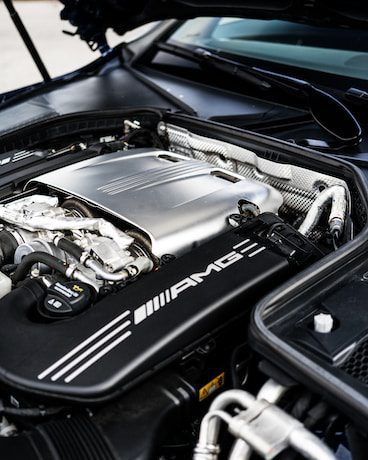
Are you noticing white smoke coming from your engine?
If you see white smoke coming from your engine, it’s important to know what’s causing it and how to fix it. Here is some helpful information to guide you through the process.
It can be shocking turning on the ignition only to see a cloud of thick white smoke coming from your engine. Most of the time, white smoke should not be a cause of concern but depending on the thickness, it could symbolize further engine trouble.
Your car exhaust system is made from various metallic parts. When driving there is a normal discharge of water vapor – it’s just that you can’t see it most of the time.
This water vapor later condenses in the exhaust pipes during the night. When you warm up your engine in the morning, it is usual to see some white smoke from the exhaust. This is normal and should not be a cause of concern.
However, if you are experiencing thick white smoke from the exhaust, you may want to have it checked. It could be that the coolant is leaking to the combustion chambers, which can damage your entire engine system.
Possible causes for white smoke from the exhaust
Condensation
This is the most common cause for white smoke from the engine – especially if you live in colder regions. Exhaust gases are very hot, and when exposed to cold air outside, condensation occurs causing white smoke.
The gases can also condense in the exhaust system, such that when you turn on your car in the morning, some white smoke is emitted from your engine. This is normal and the white smoke clears as you continue driving.
Leaking coolant
A normal combustion engine operates through the ignition of fuel/air mixture. Oil is used to lubricate the engine while keeping it cool. You also need a coolant for heat dissipation.
The combustion process produces enormous amounts of heat. The coolant is used to carry this heat from the engine to the radiator where it is cooled off and sent back to the engine block. Oil, fuel and coolant should never mix. If the coolant leaks to the engine then you are going to see a white thick smoke.
You differentiate the normal white smoke from coolant leaks by the smoke smell and if the white smoke occurs once you start driving instead of immediately after starting the engine.
The next question is how the coolant finds its way to the engine block. You can pinpoint the problem to a crack in the cylinder head. A small crack in the engine block is the beginning of further engine problems. Alternatively, the coolant has somehow mixed with the engine oil. For the later, the smoke is not only white but it has a milky appearance.
As earlier stated, the coolant plays a vital role in keeping the engine cool. When you start having leaks, then you engine starts overheating – leading to further problems.
Broken Fuel Pumping Injection
This is mainly relegated to diesel engines that require a precise timing in the fuel pumping injection. When this is faulty you have more fuel going into the combustion chamber which when not completely burned is ejected through the exhaust as a white smoke.
This kind of smoke is noticeable the moment you start the engine. A broken fuel pumping injection is not a simple DIY, you will need a certified mechanic to check out the system and so repairs.
Leaking valve seals or piston ring
Oil should never be allowed to mix with the fuel/air mixture in the combustion chamber. Valve seals and the piston rings help keep oil out. However, if you oil finds its way into the combustion chamber, it will be released as a white or bluish smoke.
The smoke can also be milky meaning the oil is mixed with the coolant before entering the combustion chamber. You can check the coolant and oil levels when starting a journey to properly diagnose the problem. If there is a drop then know you are experiencing leaks.
Note that when the white smoke appears when the engine is running it could be a symptom of further engine problems. You may need to have the head gasket, cylinder head and fuel filter checked.
Faulty Fuel injector
For proper operation of the car, there is a need for the right mixture of fuel and air. If you have a faulty fuel injector the too much fuel is delivered to the combustion chambers, which when not burned properly comes out through the exhaust system as white smoke.
How to fix White smoke from engine
Inspect the Intake gasket
This is the first place you should focus your search in cases of white smoke. The intake gasket is what covers your engine head manifold. This gasket prevents the coolant from getting into intake ports and the to the combustion chamber.
When it is damaged or leaking, you will notice white smoke when you start the engine. Repair the intake gasket involves removing the entire intake manifold and checking the intake gasket for signs of rust or leaks. Replacing will be the next step.
If you discover that the intake gasket is working fine and there no signs of damage, the next step is to examine the head gasket. This gasket prevents the coolant from getting to the combustion chambers. If it is leaking, replace it.
Cracked cylinder head
Now we are talking expensive. The cylinder head connects the head gasket to the engine block. Since it is made from aluminum it is prone to overheating hence developing cracks. You will need help from your mechanic to check it out and replace it otherwise it will be catastrophic driving a car with a cracked cylinder head.
Why you should not ignore white smoke from exhaust
If you notice white smoke the moment you start the engine then this is not a cause of concern as it will clear out as you continue driving. The probable cause is condensation.
However, if the white smoke has a sweet smell, it signals the coolant is leaking. Leaking coolant is dangerous as it exposes your engine to constant overheating.
This will lead to further engine damage. You can check the coolant pressure to confirm that it is the source of the leaks.
Sometimes the white smoke has the smell of gas. This means your fuel injectors are faulty hence delivering more gas to the combustion chamber. Engine misfires often accompany excessive gas in the combustion chambers. This leads to your car consuming more fuel.
There also those moments when the white smoke is emitted when your car is idle. The most probable cause is that your oil leaks into the combustion chamber.
You can differentiate this from other white smoke as it is accompanied with a bluish smoke. Oil leaks are dangerous to your engine as it will destroy other engine parts like the spark plugs.
Conclusion
White smoke is normal when it happens through condensation. You will spot this when you switch on your car in the morning. This smoke soon clears as you continue driving.
However, if you notice that your car is still emitting white smoke as you accelerate then it could be a signal that your coolant is leaking, you have a cracked cylinder, oil has found its way into the combustion chambers or you have faulty fuel injectors. White smoke should be checked and fixed immediately to prevent further engine trouble.
